Millions of years ago, North American mammals flooded South America after the two continents joined. But South American mammals failed to return the favor, and now scientists have an idea why.
A new analysis of fossils suggests that many native South American mammal groups were declining early in the continental coupling, leaving fewer species available to head north, researchers report October 5 in the Proceedings of the National Academy of Sciences.
More than 10 million years ago, as the Pacific tectonic plate slid under the South American and Caribbean plates, the Isthmus of Panama began to rise out of the ocean, bridging North and South America. Animals began to move between the continents, in a trickle at first and then in a massive wave after the isthmus had fully formed around 3 million years ago. This exchange, known as the Great American Biotic Interchange, had a major influence on the distribution of mammals in the Americas today.
South American mammals at the time of the event — having evolved for tens of millions of years on an island continent — were stupendously strange. Club-tailed armadillo relatives the size of small cars shuffled about (SN: 2/22/16). Vaguely camel-like and rhinolike herbivores grazed the landscape. Immense ground sloths shambled on land and even swam offshore.
“This interchange was relatively balanced at first,” says Juan Carrillo, a paleobiologist at the National Museum of Natural History in Paris. But eventually, the switcheroo became asymmetric, with many more mammals with North American origins showing up in the south than vice versa. In fact, most of South America’s extraordinary creatures never managed to move north and persist into the modern era.
That pattern persists to this day. Nearly half of modern South American mammal genera can trace their origins to North America, but only 10 percent of northern mammals (excluding those in Central America) are descended from South American migrants. We now think of jaguars and llamas as quintessential examples of South American wildlife, for example, but their ancestors came across the isthmus from North America. Today, the remaining transplants from South America include animals like porcupines, armadillos and opossums.
The reasons for this pattern are unclear, Carrillo says. Northern mammals could have become more prevalent because, for some reason, they were better at spreading into South America than southern mammals were at moving north. Alternatively, perhaps northern newcomers to South America evolved into many more species once they infiltrated the new landmass. Or perhaps South America’s native mammals went extinct more frequently than their northern counterparts, forming an imbalance as they disappeared. Or some combination of these scenarios could have occurred.
To test these possibilities, Carrillo and his team analyzed roughly 20,000 fossils of mammals from the Americas, using a computer simulation to estimate how fast the creatures were diversifying into new species, migrating or going extinct. The team found that overall, mammals from both continents evolved and spread at roughly the same rates. However, the simulation showed that South American mammals started disproportionately dying out during the Pliocene, about 5 million to 2.5 million years ago.

Some of these animals were quite successful until then, and even infiltrated North America. But many other southern mammal species went extinct during this period, the researchers found. The timing of the extinctions is surprising, Carrillo says, as they predate the bulk of the migrations across the isthmus, which started around 2.7 million years ago and continued into the more recent Pleistocene Epoch.
It’s not clear what was behind these extinctions. During the Pliocene, much of the globe was becoming colder. Large swaths of southern South America were also getting drier than they had been, accelerating the expansion of grasslands and the loss of forests. Such environmental upheaval may have pushed some mammal species too far.
What’s more, compared with other North American mammals, northern carnivores — like cats, dogs and bears — were particularly successful at diversifying into different species after immigrating to South America, the team found. The main southern predators that the northern animals would have encountered across the isthmus were sparassodonts — strange meat eaters related to marsupials —which were already in decline and died out entirely not long after the isthmus fully formed. Carrillo says the waning of sparassodonts may have left an opening for northern carnivores.
“Basically, they left this empty ecological space,” he says, at the same time that the southern extinctions left fewer species available to embark on a northward trek.
Still, it’s possible that direct competition with northern predators caused some of these southern extinctions, says Jens-Christian Svenning, an ecologist at Aarhus University in Denmark who was not involved with the study. That trend could be revealed with a more complete fossil record, he says. After all, you would expect fairly intense competition between sparassodonts and northern carnivores, Svenning says, and the unprovoked extinction of sparassodonts “seems mysterious.”
Potentially inaccurate classification of fossils in the record may also make determining biodiversity trends like those described in the new study tricky, says Dimila Mothé, a paleontologist at the Federal University of the State of Rio de Janeiro.
Carrillo is interested in filling gaps in the fossil record to get a fuller picture of the exchange. Most mammal fossils during this period come from higher latitudes on either continent, places like today’s Argentina or the United States. Very little is known about what animals in the tropics were going through during the exchange.
Understanding the Great American Biotic Interchange is key to understanding the history of how life evolved in the Americas, Carrillo says. “It shows this very close link between geology and biology, and how historical events, like a higher extinction [rate] of mammals, end up having important repercussions on the patterns of diversity that we see today.”










